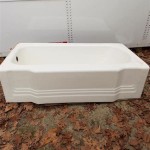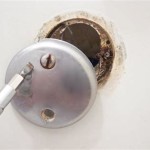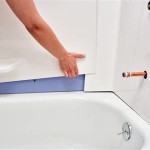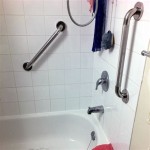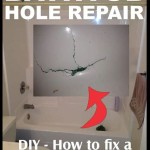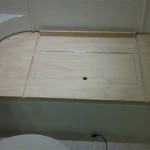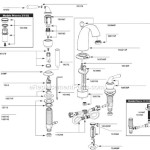Unclog Bathtub Drain Tool: A Comprehensive Guide
A clogged bathtub drain is a common household problem that can cause significant inconvenience. Standing water, slow drainage, and unpleasant odors are all indicators of a blockage hindering the proper flow of water through the drain system. Addressing this issue promptly is crucial to prevent further complications, such as overflowing tubs, potential water damage, and the growth of mold and mildew. Fortunately, a variety of tools are available to tackle these clogs efficiently, ranging from simple plungers to more specialized devices. This article provides a comprehensive overview of unclog bathtub drain tools, their functionalities, and their appropriate applications.
The choice of which tool to use depends on the severity and nature of the clog. Minor blockages caused by hair and soap scum may be resolved with basic tools, while more stubborn obstructions might require more forceful or specialized equipment. Understanding the different types of tools and their mechanisms will empower individuals to select the most effective approach for their specific situation. Regular maintenance and preventative measures are also essential to minimize the frequency of clogs and maintain a properly functioning drainage system.
Understanding the Common Causes of Bathtub Drain Clogs
Identifying the primary culprits behind bathtub drain clogs is the first step in selecting the appropriate tool and implementing preventative strategies. The most frequent causes include:
Hair: Human hair is a major contributor to drain clogs. Strands of hair easily tangle and accumulate within the drainpipe, forming a dense mat that traps other debris and restricts water flow. Long hair, in particular, is prone to winding around drain components and becoming deeply entrenched within the pipe system.
Soap Scum: Soaps, shampoos, and conditioners often contain fatty acids that react with minerals in hard water to form soap scum. This sticky residue adheres to the inner walls of the drainpipe, gradually building up and narrowing the passageway. Over time, soap scum can harden and become extremely difficult to remove.
Bath Products: Small pieces of bath bombs, bath salts, and other bath products can also contribute to drain clogs. These items may not dissolve completely and can accumulate in the drainpipe, especially if they are combined with hair and soap scum.
Dirt and Sediment: Dirt and sediment from the body and bathwater can also wash down the drain and contribute to clogs. These particles can settle in low spots in the drainpipe and gradually accumulate, especially if the drain system is not properly maintained.
Foreign Objects: Small toys, bottle caps, and other foreign objects that accidentally fall into the drain can cause immediate and significant blockages. These objects can get lodged in the drainpipe and prevent water from flowing through.
Exploring Different Types of Unclogging Tools
Several tools are specifically designed to unclog bathtub drains, each offering a unique approach to removing blockages. Understanding the strengths and limitations of each tool is crucial for selecting the most appropriate option for a given clog. The following are among the most common and effective options:
Plunger: A plunger creates suction to dislodge the clog. The most effective type for a bathtub is a flange plunger (toilet plunger), which has a soft rubber flap that folds out from the cup. This flange creates a tighter seal around the drain opening, improving suction. To use a plunger effectively, ensure there is enough water in the tub to cover the cup of the plunger. Position the plunger over the drain opening, creating a tight seal. Push and pull the plunger up and down vigorously for several minutes, maintaining the seal. Remove the plunger to check if the water drains freely. Repeat the process if the clog persists.
Drain Snake (Auger): A drain snake, also known as an auger, is a flexible tool designed to reach deep into the drainpipe and break up or retrieve clogs. It typically consists of a long, coiled metal wire with a handle at one end. There are several types of drain snakes available, including manual snakes, power snakes, and toilet augers. For bathtub drains, a manual snake or a small power snake is often sufficient. To use a drain snake, carefully insert the end of the snake into the drain opening. Rotate the handle to advance the snake through the pipe. If the snake encounters resistance, continue rotating and pushing to break up the clog or hook onto it. Once the clog is broken up or hooked, slowly pull the snake back out of the drain, removing the debris. Flush the drain with hot water to clear any remaining residue.
Zip Tool: A zip tool, also known as a drain cleaning stick, is a long, flexible plastic tool with barbs or hooks along its length. It is designed to grab onto hair and other debris and pull it out of the drain. Zip tools are relatively inexpensive and easy to use, making them a popular choice for minor clogs. To use a zip tool, insert the tool into the drain opening and push it down as far as it will go. Rotate the tool slightly and then slowly pull it back out, removing any hair or debris that is caught on the barbs. Repeat the process several times to ensure that the drain is clear.
Wet/Dry Vacuum: A wet/dry vacuum can be used to suck out clogs from a bathtub drain. This method is particularly effective for removing loose debris and standing water from the drainpipe. To use a wet/dry vacuum, set the vacuum to the wet mode and attach a narrow nozzle to the hose. Position the nozzle over the drain opening, creating a tight seal. Turn on the vacuum and allow it to suck out any standing water and debris from the drainpipe. Repeat the process several times to ensure that the drain is clear. Be sure to clean the vacuum after use to prevent the spread of bacteria and odors.
Chemical Drain Cleaners: Chemical drain cleaners are readily available in most hardware stores and supermarkets. These cleaners contain harsh chemicals that dissolve clogs by breaking down organic matter, such as hair and soap scum. While chemical drain cleaners can be effective, they should be used with caution. They can damage pipes, especially older or corroded pipes. They can also be harmful to the environment and pose a health risk if not handled properly. Always wear gloves and eye protection when using chemical drain cleaners. Follow the manufacturer's instructions carefully. Avoid mixing different types of chemical drain cleaners, as this can create dangerous fumes. As a general rule, it is preferable to avoid chemical drain cleaners if other methods are available. Consider enzymatic drain cleaners as a somewhat less aggressive option; these use enzymes to break down organic matter.
Step-by-Step Guide to Unclogging a Bathtub Drain
The process of unclogging a bathtub drain involves a series of steps that should be followed systematically to ensure effectiveness and prevent further damage to the drain system. Begin by assessing the severity of the clog and identifying the potential cause. This will help determine the most appropriate tool and approach.
Preparation: Before starting, gather the necessary tools and materials. This may include a plunger, drain snake, zip tool, wet/dry vacuum, gloves, eye protection, and a bucket. Protect the surrounding area by covering the floor with old towels or newspapers. Ensure adequate ventilation in the bathroom.
Initial Assessment: Remove the drain stopper or strainer to gain access to the drain opening. Inspect the drain opening for any visible debris, such as hair or soap scum. If possible, remove any visible debris manually using a pair of tweezers or pliers.
Plunging: If the drain is not completely blocked and there is some standing water in the tub, attempt to unclog the drain using a plunger. Ensure that the cup of the plunger is completely submerged in water. Position the plunger over the drain opening, creating a tight seal. Push and pull the plunger up and down vigorously for several minutes, maintaining the seal. Remove the plunger to check if the water drains freely. Repeat the process if the clog persists.
Snaking: If plunging is not effective, use a drain snake to break up or retrieve the clog. Carefully insert the end of the snake into the drain opening. Rotate the handle to advance the snake through the pipe. If the snake encounters resistance, continue rotating and pushing to break up the clog or hook onto it. Once the clog is broken up or hooked, slowly pull the snake back out of the drain, removing the debris. Flush the drain with hot water to clear any remaining residue.
Zip Tool Usage: If the clog appears to be caused by hair and is located near the drain opening, a zip tool may be effective. Insert the tool into the drain opening and push it down as far as it will go. Rotate the tool slightly and then slowly pull it back out, removing any hair or debris that is caught on the barbs. Repeat the process several times to ensure that the drain is clear.
Wet/Dry Vacuum Application: If the drain is filled with standing water and loose debris, a wet/dry vacuum can be used to suck out the clog. Set the vacuum to the wet mode and attach a narrow nozzle to the hose. Position the nozzle over the drain opening, creating a tight seal. Turn on the vacuum and allow it to suck out any standing water and debris from the drainpipe. Repeat the process several times to ensure that the drain is clear.
Final Flush and Inspection: After attempting to unclog the drain using one or more of these methods, flush the drain with hot water to clear any remaining residue. Observe the water flow to ensure that the drain is functioning properly. If the drain is still clogged, repeat the process or consider seeking professional assistance from a plumber.
Reassembly: Once the drain is clear, reassemble the drain stopper or strainer. Clean up any spills or messes that may have occurred during the unclogging process. Dispose of any used materials, such as gloves and debris, properly.
By following these steps carefully, individuals can effectively unclog bathtub drains and maintain a properly functioning drainage system. Regular maintenance and preventative measures are also essential to minimize the frequency of clogs and prevent future problems.

Husky Tub Drain Removal Tool 410 075 0111 The Home Depot

Best Tools For Unclogging A Bathtub Drain

8 Pack Drain Clog Remover Plumbing Tool For Bathroom Shower Bathtub Cleaner Sink Unclogger Hair Catcher Stick Pipe Tub Com

Instant Power Drain Snake Hair Clog Remover Tool 2301 The Home Depot

5 Pack Hair Snake Drain Clog Remover Cleaning Tool Sink Suitable For Unclogging Kitchen Sinks And Bathtubs Toilets Sewer Pipe Tools Com
How To Clean The Inside Of A Bathtub Drain Without Removing It Quora

Best Tools For Unclogging A Bathtub Drain

Hair Drain Clog Remover Sewer Catcher Pipe Dredging Temu New Zealand

How To Fix A Slow Draining Tub Fischer Plumbing

How To Unclog A Bathtub Drain 11 Diy Clog Busters

